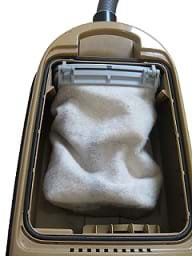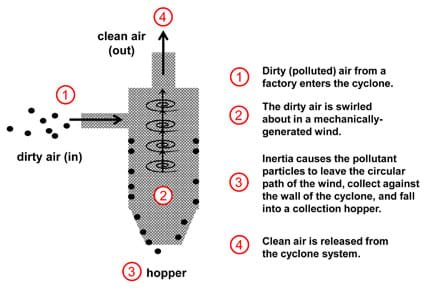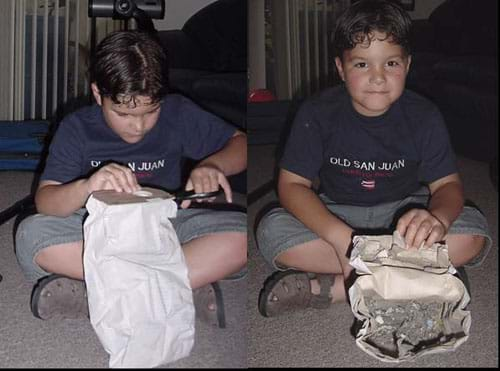Quick Look
Grade Level: 5 (4-5)
Time Required: 15 minutes
Expendable Cost/Group: US $5.00
Group Size: 28
Activity Dependency: None
NGSS Performance Expectations:

| 5-ESS3-1 |

Summary
Students observe and discuss a vacuum cleaner model of a baghouse to better understand how this pollutant recovery method functions in cleaning industrial air pollution.Engineering Connection
Environmental and mechanical engineers are continually inventing new techniques to remove the air pollutants in industrial emissions. Baghouses capture more than 99% of the particulate air pollutants from steel mills, foundries and other industrial furnaces. They work very much like a giant vacuum cleaner: Heavy dirt particles fall out and are removed, and smaller particulates are trapped in filters (bags) made of cloth or paper. Engineers design home vacuum cleaners, too.
Learning Objectives
After this activity, students should be able to:
- Describe and explain how a baghouse works to control air pollution.
- Describe how engineers create technology to help industry clean up their air pollution.
Educational Standards
Each TeachEngineering lesson or activity is correlated to one or more K-12 science,
technology, engineering or math (STEM) educational standards.
All 100,000+ K-12 STEM standards covered in TeachEngineering are collected, maintained and packaged by the Achievement Standards Network (ASN),
a project of D2L (www.achievementstandards.org).
In the ASN, standards are hierarchically structured: first by source; e.g., by state; within source by type; e.g., science or mathematics;
within type by subtype, then by grade, etc.
Each TeachEngineering lesson or activity is correlated to one or more K-12 science, technology, engineering or math (STEM) educational standards.
All 100,000+ K-12 STEM standards covered in TeachEngineering are collected, maintained and packaged by the Achievement Standards Network (ASN), a project of D2L (www.achievementstandards.org).
In the ASN, standards are hierarchically structured: first by source; e.g., by state; within source by type; e.g., science or mathematics; within type by subtype, then by grade, etc.
NGSS: Next Generation Science Standards - Science
| NGSS Performance Expectation | ||
|---|---|---|
|
5-ESS3-1. Obtain and combine information about ways individual communities use science ideas to protect the Earth's resources and environment. (Grade 5) Do you agree with this alignment? |
||
| Click to view other curriculum aligned to this Performance Expectation | ||
| This activity focuses on the following Three Dimensional Learning aspects of NGSS: | ||
| Science & Engineering Practices | Disciplinary Core Ideas | Crosscutting Concepts |
| Obtain and combine information from books and/or other reliable media to explain phenomena or solutions to a design problem. Alignment agreement: | Human activities in agriculture, industry, and everyday life have had major effects on the land, vegetation, streams, ocean, air, and even outer space. But individuals and communities are doing things to help protect Earth's resources and environments. Alignment agreement: | A system can be described in terms of its components and their interactions. Alignment agreement: Science findings are limited to questions that can be answered with empirical evidence.Alignment agreement: |
International Technology and Engineering Educators Association - Technology
-
Students will develop an understanding of the effects of technology on the environment.
(Grades
K -
12)
More Details
Do you agree with this alignment?
-
The use of technology affects the environment in good and bad ways.
(Grades
3 -
5)
More Details
Do you agree with this alignment?
-
Explain why responsible use of technology requires sustainable management of resources.
(Grades
3 -
5)
More Details
Do you agree with this alignment?
State Standards
Colorado - Science
-
Develop, communicate, and justify a procedure to separate simple mixtures based on physical properties
(Grade
5)
More Details
Do you agree with this alignment?
Materials List
For a class demonstration:
- vacuum cleaner with a clean filter bag
- 1 cup soil (or something dirty to vacuum up)
- scissors
- How a Baghouse Cleans Polluted Air Diagram, a PDF suitable for an overhead projector transparency or student handout
Worksheets and Attachments
Visit [www.teachengineering.org/activities/view/cub_air_lesson10_activity4] to print or download.Introduction/Motivation
Environmental and mechanical engineers are continually inventing new techniques to remove the air pollutants in industrial emissions. In this lesson, we have examined the use of water, static electricity and circular motion to help remove even tiny particles from polluted air. Can you think of any other ways to remove particles from the air? Another method designed by environmental engineers is a type of technology called a baghouse. A baghouse works a lot like a vacuum cleaner. Can you explain how a vacuum cleaner works?
Baghouses are used to control air pollutants from steel mills, foundries and other industrial furnaces, and can collect more than 99% of the particulates. Baghouses work very much like a giant vacuum. Heavy dirt particles fall out and are removed, and smaller particulates are trapped in filters (bags) made of cloth, paper or similar materials. Particles are shaken or blown from the filters down into a collection hopper. Refer to Figure 1 or the attached How a Baghouse Cleans Polluted Air Diagram.

Imagine a large vacuum cleaner suctioning particles out of the air. Would you want the bag material to be a loose weave or a tight weave? In a class demonstration today, we are going to look at how a baghouse works.
Procedure
Before the Activity
- Gather materials.
- Clear an area suitable for dirt to be spread and vacuumed.
With the Students
- Brainstorm with the students. Do you know how a vacuum cleaner works? What happens to the dirt once it is vacuumed up? Where does it go? Write student ideas on the chalkboard, paying particular attention to what they think happens to the suctioned materials.
- Ask the students if they think we could use some kind of vacuum cleaner to clean up polluted air. What would be needed for it to work? (Answer: A very fine filter.)
- Remove the clean filter bag from the vacuum cleaner so the students can see that it is clean. (Depending on the type of bag, you may need to open it for viewing and then reseal it.)
- Ask the students to record their observations during the activity.
- Sprinkle some soil on the floor and use the vacuum cleaner to clean up the mess.
- Remove the vacuum bag and cut it open to show the inside of the bag (see Figure 2).

- Discuss student observations. Explain to the students that a baghouse is simply a fine filter that polluted (dirty) air is forced through as a way to capture the pollutants. This is similar to the vacuum cleaners used in their homes.
- In conclusion, ask the students the following questions and discuss as a class:
- Does the baghouse remove all of the particulates? (Answer: No, not all of them. Baghouses are 99% efficient.)
- How does this compare to the efficiency of a wet scrubber? Which one is better? (Answer: A wet scrubber is 95% efficient, so baghouses are more efficient).
- If baghouses are more efficient, why would you ever want to use a wet scrubber? (Answer: It depends on the type of air pollution. Wet scrubbers work better on gases.)
Assessment
Pre-Activity Assessment
Brainstorming: As a class, have the students engage in open discussion. Remind students that in brainstorming, no idea or suggestion is "silly." All ideas should be respectfully heard. Take an uncritical position, encourage wild ideas and discourage criticism of ideas. Have students raise their hands to respond. Write their ideas on the board. Ask the students:
- Do you know how a vacuum cleaner works?
- What happens to the dirt once it is vacuumed up? Where does it go?
Discussion Question: Ask the students if they think we could use some kind of vacuum cleaner to clean polluted air. What would be needed for it to work? (Answer: A very fine filter.)
Activity Embedded Assessment
Observations: Have students pay close attention and record their observations of the activity, explaining to them that this is what real scientists and engineers do. Instruct them to record anything that seems important.
Post-Activity Assessment
Observations: Discuss student observations.
Drawing/Journaling: Depending on the students' skill level, have them draw a picture or write in their own words a description of how a baghouse works to clean polluted air. Ask for volunteers to share their descriptions with the class.
Safety Issues
- Make sure students do not stick their hand or other large objects in the path of the vacuum cleaner.
- Remind students to be careful with the scissors.
Troubleshooting Tips
If bringing the vacuum cleaner machine to the classroom is problematic, simplify the activity by bringing in two vacuum cleaner bags, one clean and one dirty, and cutting them open.
Activity Extensions
Find local examples of baghouses and arrange a field trip. What pollutants does this baghouse remove? What do they do with the collected particulates?
Activity Scaling
- This activity is appropriate for all age levels.
- For upper grades, add a math component. Give students a number of particulates and have them calculate how many are cleaned out of the air using baghouses with 99% efficiency. (For example, if 100,000 particulates went through a baghouse, about 100,000 x 0.99 = 99,000 would be removed and 1,000 would remain.
Subscribe
Get the inside scoop on all things TeachEngineering such as new site features, curriculum updates, video releases, and more by signing up for our newsletter!More Curriculum Like This

Students are introduced to the concepts of air pollution and technologies that engineers have developed to reduce air pollution. They develop an understanding of visible air pollutants with an incomplete combustion demonstration, a "smog in a jar" demonstration, construction of simple particulate ma...

To develop an understanding of modern industrial technologies that clean up and prevent air pollution, students build and observe a variety of simple models of engineering pollutant recovery methods: scrubber, electrostatic precipitator, cyclone and baghouse. In an associated literacy activity, stud...
References
Markle, Sandra. The Kids' Earth Handbook. Atheneum, NY: John Wiley & Sons, Inc, 1991.
Copyright
© 2004 by Regents of the University of ColoradoContributors
Amy Kolenbrander; Sharon Perez; Janet Yowell; Natalie Mach; Gwendolyn Frank; Malinda Schaefer Zarske; Denise W. CarlsonSupporting Program
Integrated Teaching and Learning Program, College of Engineering, University of Colorado BoulderAcknowledgements
The contents of this digital library curriculum were developed under a grant from the Fund for the Improvement of Postsecondary Education (FIPSE), U.S. Department of Education and National Science Foundation GK-12 grant no. 0338326. However, these contents do not necessarily represent the policies of the Department of Education or National Science Foundation, and you should not assume endorsement by the federal government.
Last modified: August 31, 2020







User Comments & Tips